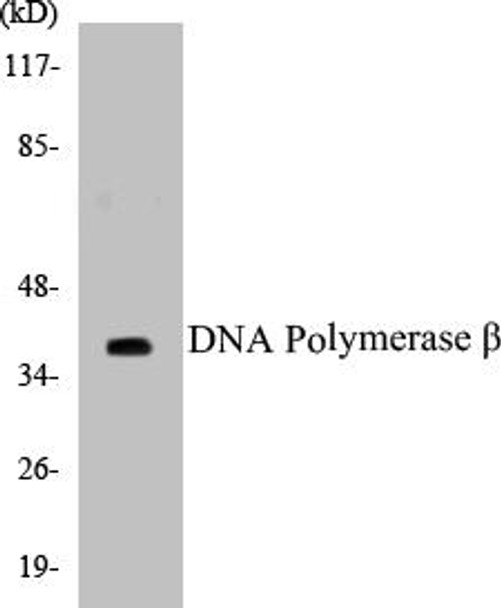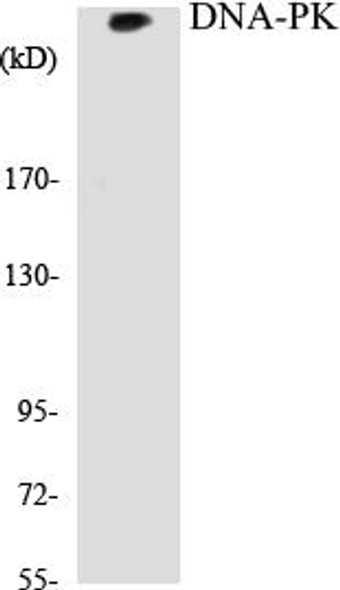Description
DNA Polymerase beta Colorimetric Cell-Based ELISA Kit
The DNA Polymerase Beta Colorimetric Cell-Based ELISA Kit offered by AssayGenie is a cutting-edge tool designed for accurate and sensitive detection of DNA polymerase beta levels in cell lysates. This kit utilizes a colorimetric assay format for easy quantification of DNA polymerase beta activity in cell samples, making it an essential tool for research in fields such as molecular biology, genetics, and cancer research.DNA polymerase beta is a key enzyme involved in DNA repair and maintenance, playing a critical role in preserving genomic integrity. Dysregulation of DNA polymerase beta activity has been linked to various diseases, including cancer, neurodegenerative disorders, and autoimmune conditions.
Therefore, accurate measurement of DNA polymerase beta levels is crucial for understanding disease mechanisms and developing targeted therapies.With its high sensitivity and specificity, the DNA Polymerase Beta Colorimetric Cell-Based ELISA Kit from AssayGenie provides researchers with reliable and reproducible results, enabling them to study the role of DNA polymerase beta in various cellular processes and pathological conditions. Whether investigating DNA repair mechanisms or evaluating potential therapeutic targets, this kit is a valuable tool for advancing scientific discovery in the field of molecular biology.
| Product Name: | DNA Polymerase beta Colorimetric Cell-Based ELISA |
| Product Code: | CBCAB00294 |
| ELISA Type: | Cell-Based |
| Target: | DNA Polymerase beta |
| Reactivity: | Human, Mouse, Rat |
| Dynamic Range: | > 5000 Cells |
| Detection Method: | Colorimetric 450 nmStorage/Stability:4°C/6 Months |
| Format: | 96-Well Microplate |
The DNA Polymerase beta Colorimetric Cell-Based ELISA Kit is a convenient, lysate-free, high throughput and sensitive assay kit that can detect DNA Polymerase beta protein expression profile in cells. The kit can be used for measuring the relative amounts of DNA Polymerase beta in cultured cells as well as screening for the effects that various treatments, inhibitors (ie siRNA or chemicals), or activators have on DNA Polymerase beta.
Qualitative determination of DNA Polymerase beta concentration is achieved by an indirect ELISA format. In essence, DNA Polymerase beta is captured by DNA Polymerase beta-specific primary antibodies while the HRP-conjugated secondary antibodies bind the Fc region of the primary antibody. Through this binding, the HRP enzyme conjugated to the secondary antibody can catalyze a colorimetric reaction upon substrate addition. Due to the qualitative nature of the Cell-Based ELISA, multiple normalization methods are needed:
| 1. | A monoclonal antibody specific for human GAPDH is included to serve as an internal positive control in normalizing the target absorbance values. |
| 2. | Following the colorimetric measurement of HRP activity via substrate addition, the Crystal Violet whole-cell staining method may be used to determine cell density. After staining, the results can be analysed by normalizing the absorbance values to cell amounts, by which the plating difference can be adjusted. |
| Database Information: | Gene ID: 5423, UniProt ID: P06746, OMIM: 174760, Unigene: Hs.654484 |
| Gene Symbol: | POLB |
| Sub Type: | None |
| UniProt Protein Function: | POLB: Repair polymerase that plays a key role in base-excision repair. Has 5'-deoxyribose-5-phosphate lyase (dRP lyase) activity that removes the 5' sugar phosphate and also acts as a DNA polymerase that adds one nucleotide to the 3' end of the arising single-nucleotide gap. Conducts 'gap-filling' DNA synthesis in a stepwise distributive fashion rather than in a processive fashion as for other DNA polymerases. Monomer. Interacts with APEX1, HUWE1/ARF-BP1, STUB1/CHIP and USP47. Belongs to the DNA polymerase type-X family. |
| UniProt Protein Details: | Protein type:EC 2.7.7.7; Transferase; Lyase; DNA replication; DNA repair, damage Chromosomal Location of Human Ortholog: 8p11.2 Cellular Component: nucleoplasm; microtubule; spindle microtubule; cytoplasm; nucleus Molecular Function:protein binding; enzyme binding; metal ion binding; microtubule binding; damaged DNA binding; DNA-directed DNA polymerase activity; lyase activity Biological Process: base-excision repair, gap-filling; neuron apoptosis; response to ethanol; DNA damage response, signal transduction resulting in induction of apoptosis; base-excision repair; pyrimidine dimer repair; nucleotide-excision repair, DNA gap filling; DNA repair; DNA-dependent DNA replication; response to DNA damage stimulus |
| NCBI Summary: | The protein encoded by this gene is a DNA polymerase involved in base excision and repair, also called gap-filling DNA synthesis. The encoded protein, acting as a monomer, is normally found in the cytoplasm, but it translocates to the nucleus upon DNA damage. Several transcript variants of this gene exist, but the full-length nature of only one has been described to date. [provided by RefSeq, Sep 2011] |
| UniProt Code: | P06746 |
| NCBI GenInfo Identifier: | 4505931 |
| NCBI Gene ID: | 5423 |
| NCBI Accession: | NP_002681.1 |
| UniProt Related Accession: | P06746 |
| Molecular Weight: | ~ 38kDa |
| NCBI Full Name: | DNA polymerase beta |
| NCBI Synonym Full Names: | DNA polymerase beta |
| NCBI Official Symbol: | POLB |
| NCBI Protein Information: | DNA polymerase beta |
| UniProt Protein Name: | DNA polymerase beta |
| UniProt Gene Name: | POLB |
| UniProt Entry Name: | DPOLB_HUMAN |
| Component | Quantity |
| 96-Well Cell Culture Clear-Bottom Microplate | 2 plates |
| 10X TBS | 24 mL |
| Quenching Buffer | 24 mL |
| Blocking Buffer | 50 mL |
| 15X Wash Buffer | 50 mL |
| Primary Antibody Diluent | 12 mL |
| 100x Anti-Phospho Target Antibody | 60 µL |
| 100x Anti-Target Antibody | 60 µL |
| Anti-GAPDH Antibody | 60 µL |
| HRP-Conjugated Anti-Rabbit IgG Antibody | 12 mL |
| HRP-Conjugated Anti-Mouse IgG Antibody | 12 mL |
| SDS Solution | 12 mL |
| Stop Solution | 24 mL |
| Ready-to-Use Substrate | 12 mL |
| Crystal Violet Solution | 12 mL |
| Adhesive Plate Seals | 2 seals |
The following materials and/or equipment are NOT provided in this kit but are necessary to successfully conduct the experiment:
- Microplate reader able to measure absorbance at 450 nm and/or 595 nm for Crystal Violet Cell Staining (Optional)
- Micropipettes with capability of measuring volumes ranging from 1 µL to 1 ml
- 37% formaldehyde (Sigma Cat# F-8775) or formaldehyde from other sources
- Squirt bottle, manifold dispenser, multichannel pipette reservoir or automated microplate washer
- Graph paper or computer software capable of generating or displaying logarithmic functions
- Absorbent papers or vacuum aspirator
- Test tubes or microfuge tubes capable of storing ≥1 ml
- Poly-L-Lysine (Sigma Cat# P4832 for suspension cells)
- Orbital shaker (optional)
- Deionized or sterile water
*Note: Protocols are specific to each batch/lot. For the correct instructions please follow the protocol included in your kit.
| Step | Procedure |
| 1. | Seed 200 µL of 20,000 adherent cells in culture medium in each well of a 96-well plate. The plates included in the kit are sterile and treated for cell culture. For suspension cells and loosely attached cells, coat the plates with 100 µL of 10 µg/ml Poly-L-Lysine (not included) to each well of a 96-well plate for 30 minutes at 37°C prior to adding cells. |
| 2. | Incubate the cells for overnight at 37°C, 5% CO2. |
| 3. | Treat the cells as desired. |
| 4. | Remove the cell culture medium and rinse with 200 µL of 1x TBS, twice. |
| 5. | Fix the cells by incubating with 100 µL of Fixing Solution for 20 minutes at room temperature. The 4% formaldehyde is used for adherent cells and 8% formaldehyde is used for suspension cells and loosely attached cells. |
| 6. | Remove the Fixing Solution and wash the plate 3 times with 200 µL 1x Wash Buffer for five minutes each time with gentle shaking on the orbital shaker. The plate can be stored at 4°C for a week. |
| 7. | Add 100 µL of Quenching Buffer and incubate for 20 minutes at room temperature. |
| 8. | Wash the plate 3 times with 1x Wash Buffer for 5 minutes each time. |
| 9. | Add 200 µL of Blocking Buffer and incubate for 1 hour at room temperature. |
| 10. | Wash 3 times with 200 µL of 1x Wash Buffer for 5 minutes each time. |
| 11. | Add 50 µL of 1x primary antibodies (Anti-DNA Polymerase beta Antibody and/or Anti-GAPDH Antibody) to the corresponding wells, cover with Parafilm and incubate for 16 hours (overnight) at 4°C. If the target expression is known to be high, incubate for 2 hours at room temperature. |
| 12. | Wash 3 times with 200 µL of 1x Wash Buffer for 5 minutes each time. |
| 13. | Add 50 µL of 1x secondary antibodies (HRP-Conjugated AntiRabbit IgG Antibody or HRP-Conjugated Anti-Mouse IgG Antibody) to corresponding wells and incubate for 1.5 hours at room temperature. |
| 14. | Wash 3 times with 200 µL of 1x Wash Buffer for 5 minutes each time. |
| 15. | Add 50 µL of Ready-to-Use Substrate to each well and incubate for 30 minutes at room temperature in the dark. |
| 16. | Add 50 µL of Stop Solution to each well and read OD at 450 nm immediately using the microplate reader. |
(Additional Crystal Violet staining may be performed if desired – details of this may be found in the kit technical manual.)






